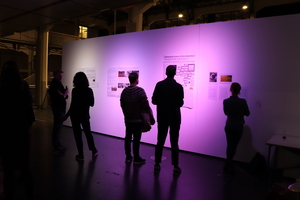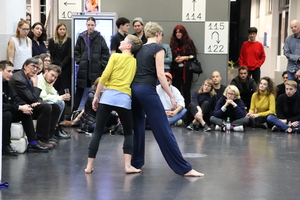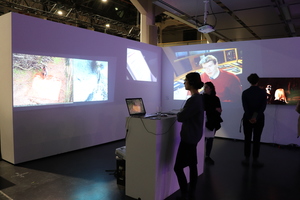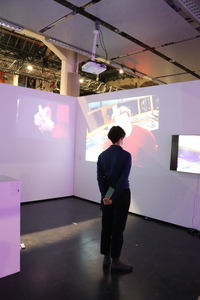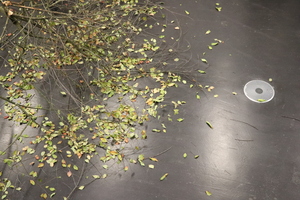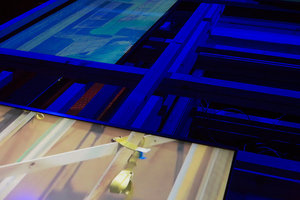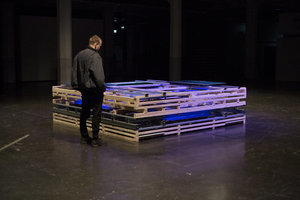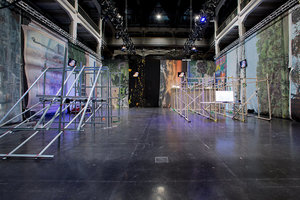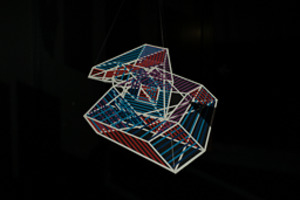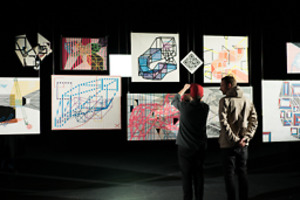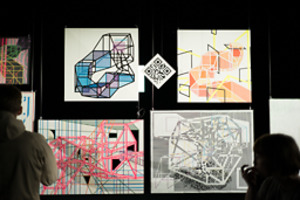"Ausstellung"
| Begriff | Ausstellung |
| Metakey | Typ des Projekts/Werks (creative_work:type) |
| Typ | Keyword |
| Vokabular | Werk |
295 Inhalte
- Seite 1 von 25
Critical Zones
- Titel
- Critical Zones
- Titel (en)
- Critical Zones
- Autor/in
- Beschreibung (de)
- “Critical Zones”: Developing concepts and approaches for grasping the New Climatic Regime (Bruno Latour), that is the transformations in the relations of humans to their “terrestrial” conditions of existence. – The seminar series of Bruno Latour at HfG analyses these transformations as epistemic breaks and shifts of knowledge by drawing an analogy to the scientific revolution in the 17th century, where, after a crisis of former sound knowledge, new epistemic systems, representations and narrations in art, science, and religion had to be constructed and reintegrated into new dispositifs of knowledge. The project tackles an important aesthetic question, which overpasses simple forms of illustration of knowledge: How central is the imaginary capacity of the arts in constructing representations and narrations that are depictions and “generators” of new knowledge systems and therefore vital means of cultural change?
The exhibition at HfG in November will display some preliminary results of the projects developed by the seminar participants. It presents an opportunity to discuss – in a mode of work-in-progress – research questions, aesthetic approaches and epistemic experiments with colleagues and students of HfG and ZKM.
Opening: Nov 7, 19:00; duration: Nov 8, 10:00-19:00, Nov 9, 10:00-15:00
HfG, mittlere Lichtbrücke
- “Critical Zones”: Developing concepts and approaches for grasping the New Climatic Regime (Bruno Latour), that is the transformations in the relations of humans to their “terrestrial” conditions of existence. – The seminar series of Bruno Latour at HfG analyses these transformations as epistemic breaks and shifts of knowledge by drawing an analogy to the scientific revolution in the 17th century, where, after a crisis of former sound knowledge, new epistemic systems, representations and narrations in art, science, and religion had to be constructed and reintegrated into new dispositifs of knowledge. The project tackles an important aesthetic question, which overpasses simple forms of illustration of knowledge: How central is the imaginary capacity of the arts in constructing representations and narrations that are depictions and “generators” of new knowledge systems and therefore vital means of cultural change?
- Beschreibung (en)
- “Critical Zones”: Developing concepts and approaches for grasping the New Climatic Regime (Bruno Latour), that is the transformations in the relations of humans to their “terrestrial” conditions of existence. – The seminar series of Bruno Latour at HfG analyses these transformations as epistemic breaks and shifts of knowledge by drawing an analogy to the scientific revolution in the 17th century, where, after a crisis of former sound knowledge, new epistemic systems, representations and narrations in art, science, and religion had to be constructed and reintegrated into new dispositifs of knowledge. The project tackles an important aesthetic question, which overpasses simple forms of illustration of knowledge: How central is the imaginary capacity of the arts in constructing representations and narrations that are depictions and “generators” of new knowledge systems and therefore vital means of cultural change?
The exhibition at HfG in November will display some preliminary results of the projects developed by the seminar participants. It presents an opportunity to discuss – in a mode of work-in-progress – research questions, aesthetic approaches and epistemic experiments with colleagues and students of HfG and ZKM.
Opening: Nov 7, 19:00; duration: Nov 8, 10:00-19:00, Nov 9, 10:00-15:00
HfG, mittlere Lichtbrücke
- “Critical Zones”: Developing concepts and approaches for grasping the New Climatic Regime (Bruno Latour), that is the transformations in the relations of humans to their “terrestrial” conditions of existence. – The seminar series of Bruno Latour at HfG analyses these transformations as epistemic breaks and shifts of knowledge by drawing an analogy to the scientific revolution in the 17th century, where, after a crisis of former sound knowledge, new epistemic systems, representations and narrations in art, science, and religion had to be constructed and reintegrated into new dispositifs of knowledge. The project tackles an important aesthetic question, which overpasses simple forms of illustration of knowledge: How central is the imaginary capacity of the arts in constructing representations and narrations that are depictions and “generators” of new knowledge systems and therefore vital means of cultural change?
- Typ des Projekts/Werks
- Schlagworte
- Datierung
- 07.11.2018 - 09.11.2018
- Mitwirkende
- Ort: Institution
- Ort
- mittlere Lichtbrücke
- Stadt
- Land
- Beteiligte Institution(en)
- Titel
- Critical Zones
- Titel (en)
- Critical Zones
- Urheberrechtshinweis
- Hochschule für Gestaltung Karlsruhe
- Rechtsschutz/Lizenz
- Freigabe Nutzung HfG
- Projektleiter/in
- Semester
- Importiert am
- 10.01.2019
- Übergeordnete Sets
- 1
Critical Zones
- Titel
- Critical Zones
- Titel (en)
- Critical Zones
- Autor/in
- Beschreibung (de)
- “Critical Zones”: Developing concepts and approaches for grasping the New Climatic Regime (Bruno Latour), that is the transformations in the relations of humans to their “terrestrial” conditions of existence. – The seminar series of Bruno Latour at HfG analyses these transformations as epistemic breaks and shifts of knowledge by drawing an analogy to the scientific revolution in the 17th century, where, after a crisis of former sound knowledge, new epistemic systems, representations and narrations in art, science, and religion had to be constructed and reintegrated into new dispositifs of knowledge. The project tackles an important aesthetic question, which overpasses simple forms of illustration of knowledge: How central is the imaginary capacity of the arts in constructing representations and narrations that are depictions and “generators” of new knowledge systems and therefore vital means of cultural change?
The exhibition at HfG in November will display some preliminary results of the projects developed by the seminar participants. It presents an opportunity to discuss – in a mode of work-in-progress – research questions, aesthetic approaches and epistemic experiments with colleagues and students of HfG and ZKM.
Opening: Nov 7, 19:00; duration: Nov 8, 10:00-19:00, Nov 9, 10:00-15:00
HfG, mittlere Lichtbrücke
- “Critical Zones”: Developing concepts and approaches for grasping the New Climatic Regime (Bruno Latour), that is the transformations in the relations of humans to their “terrestrial” conditions of existence. – The seminar series of Bruno Latour at HfG analyses these transformations as epistemic breaks and shifts of knowledge by drawing an analogy to the scientific revolution in the 17th century, where, after a crisis of former sound knowledge, new epistemic systems, representations and narrations in art, science, and religion had to be constructed and reintegrated into new dispositifs of knowledge. The project tackles an important aesthetic question, which overpasses simple forms of illustration of knowledge: How central is the imaginary capacity of the arts in constructing representations and narrations that are depictions and “generators” of new knowledge systems and therefore vital means of cultural change?
- Beschreibung (en)
- “Critical Zones”: Developing concepts and approaches for grasping the New Climatic Regime (Bruno Latour), that is the transformations in the relations of humans to their “terrestrial” conditions of existence. – The seminar series of Bruno Latour at HfG analyses these transformations as epistemic breaks and shifts of knowledge by drawing an analogy to the scientific revolution in the 17th century, where, after a crisis of former sound knowledge, new epistemic systems, representations and narrations in art, science, and religion had to be constructed and reintegrated into new dispositifs of knowledge. The project tackles an important aesthetic question, which overpasses simple forms of illustration of knowledge: How central is the imaginary capacity of the arts in constructing representations and narrations that are depictions and “generators” of new knowledge systems and therefore vital means of cultural change?
The exhibition at HfG in November will display some preliminary results of the projects developed by the seminar participants. It presents an opportunity to discuss – in a mode of work-in-progress – research questions, aesthetic approaches and epistemic experiments with colleagues and students of HfG and ZKM.
Opening: Nov 7, 19:00; duration: Nov 8, 10:00-19:00, Nov 9, 10:00-15:00
HfG, mittlere Lichtbrücke
- “Critical Zones”: Developing concepts and approaches for grasping the New Climatic Regime (Bruno Latour), that is the transformations in the relations of humans to their “terrestrial” conditions of existence. – The seminar series of Bruno Latour at HfG analyses these transformations as epistemic breaks and shifts of knowledge by drawing an analogy to the scientific revolution in the 17th century, where, after a crisis of former sound knowledge, new epistemic systems, representations and narrations in art, science, and religion had to be constructed and reintegrated into new dispositifs of knowledge. The project tackles an important aesthetic question, which overpasses simple forms of illustration of knowledge: How central is the imaginary capacity of the arts in constructing representations and narrations that are depictions and “generators” of new knowledge systems and therefore vital means of cultural change?
- Typ des Projekts/Werks
- Schlagworte
- Datierung
- 07.11.2018 - 09.11.2018
- Mitwirkende
- Ort: Institution
- Ort
- mittlere Lichtbrücke
- Stadt
- Land
- Beteiligte Institution(en)
- Titel
- Critical Zones
- Titel (en)
- Critical Zones
- Urheberrechtshinweis
- Hochschule für Gestaltung Karlsruhe
- Rechtsschutz/Lizenz
- Freigabe Nutzung HfG
- Projektleiter/in
- Semester
- Importiert am
- 10.01.2019
- Übergeordnete Sets
- 1
Critical Zones
- Titel
- Critical Zones
- Titel (en)
- Critical Zones
- Autor/in
- Beschreibung (de)
- “Critical Zones”: Developing concepts and approaches for grasping the New Climatic Regime (Bruno Latour), that is the transformations in the relations of humans to their “terrestrial” conditions of existence. – The seminar series of Bruno Latour at HfG analyses these transformations as epistemic breaks and shifts of knowledge by drawing an analogy to the scientific revolution in the 17th century, where, after a crisis of former sound knowledge, new epistemic systems, representations and narrations in art, science, and religion had to be constructed and reintegrated into new dispositifs of knowledge. The project tackles an important aesthetic question, which overpasses simple forms of illustration of knowledge: How central is the imaginary capacity of the arts in constructing representations and narrations that are depictions and “generators” of new knowledge systems and therefore vital means of cultural change?
The exhibition at HfG in November will display some preliminary results of the projects developed by the seminar participants. It presents an opportunity to discuss – in a mode of work-in-progress – research questions, aesthetic approaches and epistemic experiments with colleagues and students of HfG and ZKM.
Opening: Nov 7, 19:00; duration: Nov 8, 10:00-19:00, Nov 9, 10:00-15:00
HfG, mittlere Lichtbrücke
- “Critical Zones”: Developing concepts and approaches for grasping the New Climatic Regime (Bruno Latour), that is the transformations in the relations of humans to their “terrestrial” conditions of existence. – The seminar series of Bruno Latour at HfG analyses these transformations as epistemic breaks and shifts of knowledge by drawing an analogy to the scientific revolution in the 17th century, where, after a crisis of former sound knowledge, new epistemic systems, representations and narrations in art, science, and religion had to be constructed and reintegrated into new dispositifs of knowledge. The project tackles an important aesthetic question, which overpasses simple forms of illustration of knowledge: How central is the imaginary capacity of the arts in constructing representations and narrations that are depictions and “generators” of new knowledge systems and therefore vital means of cultural change?
- Beschreibung (en)
- “Critical Zones”: Developing concepts and approaches for grasping the New Climatic Regime (Bruno Latour), that is the transformations in the relations of humans to their “terrestrial” conditions of existence. – The seminar series of Bruno Latour at HfG analyses these transformations as epistemic breaks and shifts of knowledge by drawing an analogy to the scientific revolution in the 17th century, where, after a crisis of former sound knowledge, new epistemic systems, representations and narrations in art, science, and religion had to be constructed and reintegrated into new dispositifs of knowledge. The project tackles an important aesthetic question, which overpasses simple forms of illustration of knowledge: How central is the imaginary capacity of the arts in constructing representations and narrations that are depictions and “generators” of new knowledge systems and therefore vital means of cultural change?
The exhibition at HfG in November will display some preliminary results of the projects developed by the seminar participants. It presents an opportunity to discuss – in a mode of work-in-progress – research questions, aesthetic approaches and epistemic experiments with colleagues and students of HfG and ZKM.
Opening: Nov 7, 19:00; duration: Nov 8, 10:00-19:00, Nov 9, 10:00-15:00
HfG, mittlere Lichtbrücke
- “Critical Zones”: Developing concepts and approaches for grasping the New Climatic Regime (Bruno Latour), that is the transformations in the relations of humans to their “terrestrial” conditions of existence. – The seminar series of Bruno Latour at HfG analyses these transformations as epistemic breaks and shifts of knowledge by drawing an analogy to the scientific revolution in the 17th century, where, after a crisis of former sound knowledge, new epistemic systems, representations and narrations in art, science, and religion had to be constructed and reintegrated into new dispositifs of knowledge. The project tackles an important aesthetic question, which overpasses simple forms of illustration of knowledge: How central is the imaginary capacity of the arts in constructing representations and narrations that are depictions and “generators” of new knowledge systems and therefore vital means of cultural change?
- Typ des Projekts/Werks
- Schlagworte
- Datierung
- 07.11.2018 - 09.11.2018
- Mitwirkende
- Ort: Institution
- Ort
- mittlere Lichtbrücke
- Stadt
- Land
- Beteiligte Institution(en)
- Titel
- Critical Zones
- Titel (en)
- Critical Zones
- Urheberrechtshinweis
- Hochschule für Gestaltung Karlsruhe
- Rechtsschutz/Lizenz
- Freigabe Nutzung HfG
- Projektleiter/in
- Semester
- Importiert am
- 10.01.2019
- Übergeordnete Sets
- 1
Critical Zones
- Titel
- Critical Zones
- Titel (en)
- Critical Zones
- Autor/in
- Beschreibung (de)
- “Critical Zones”: Developing concepts and approaches for grasping the New Climatic Regime (Bruno Latour), that is the transformations in the relations of humans to their “terrestrial” conditions of existence. – The seminar series of Bruno Latour at HfG analyses these transformations as epistemic breaks and shifts of knowledge by drawing an analogy to the scientific revolution in the 17th century, where, after a crisis of former sound knowledge, new epistemic systems, representations and narrations in art, science, and religion had to be constructed and reintegrated into new dispositifs of knowledge. The project tackles an important aesthetic question, which overpasses simple forms of illustration of knowledge: How central is the imaginary capacity of the arts in constructing representations and narrations that are depictions and “generators” of new knowledge systems and therefore vital means of cultural change?
The exhibition at HfG in November will display some preliminary results of the projects developed by the seminar participants. It presents an opportunity to discuss – in a mode of work-in-progress – research questions, aesthetic approaches and epistemic experiments with colleagues and students of HfG and ZKM.
Opening: Nov 7, 19:00; duration: Nov 8, 10:00-19:00, Nov 9, 10:00-15:00
HfG, mittlere Lichtbrücke
- “Critical Zones”: Developing concepts and approaches for grasping the New Climatic Regime (Bruno Latour), that is the transformations in the relations of humans to their “terrestrial” conditions of existence. – The seminar series of Bruno Latour at HfG analyses these transformations as epistemic breaks and shifts of knowledge by drawing an analogy to the scientific revolution in the 17th century, where, after a crisis of former sound knowledge, new epistemic systems, representations and narrations in art, science, and religion had to be constructed and reintegrated into new dispositifs of knowledge. The project tackles an important aesthetic question, which overpasses simple forms of illustration of knowledge: How central is the imaginary capacity of the arts in constructing representations and narrations that are depictions and “generators” of new knowledge systems and therefore vital means of cultural change?
- Beschreibung (en)
- “Critical Zones”: Developing concepts and approaches for grasping the New Climatic Regime (Bruno Latour), that is the transformations in the relations of humans to their “terrestrial” conditions of existence. – The seminar series of Bruno Latour at HfG analyses these transformations as epistemic breaks and shifts of knowledge by drawing an analogy to the scientific revolution in the 17th century, where, after a crisis of former sound knowledge, new epistemic systems, representations and narrations in art, science, and religion had to be constructed and reintegrated into new dispositifs of knowledge. The project tackles an important aesthetic question, which overpasses simple forms of illustration of knowledge: How central is the imaginary capacity of the arts in constructing representations and narrations that are depictions and “generators” of new knowledge systems and therefore vital means of cultural change?
The exhibition at HfG in November will display some preliminary results of the projects developed by the seminar participants. It presents an opportunity to discuss – in a mode of work-in-progress – research questions, aesthetic approaches and epistemic experiments with colleagues and students of HfG and ZKM.
Opening: Nov 7, 19:00; duration: Nov 8, 10:00-19:00, Nov 9, 10:00-15:00
HfG, mittlere Lichtbrücke
- “Critical Zones”: Developing concepts and approaches for grasping the New Climatic Regime (Bruno Latour), that is the transformations in the relations of humans to their “terrestrial” conditions of existence. – The seminar series of Bruno Latour at HfG analyses these transformations as epistemic breaks and shifts of knowledge by drawing an analogy to the scientific revolution in the 17th century, where, after a crisis of former sound knowledge, new epistemic systems, representations and narrations in art, science, and religion had to be constructed and reintegrated into new dispositifs of knowledge. The project tackles an important aesthetic question, which overpasses simple forms of illustration of knowledge: How central is the imaginary capacity of the arts in constructing representations and narrations that are depictions and “generators” of new knowledge systems and therefore vital means of cultural change?
- Typ des Projekts/Werks
- Schlagworte
- Datierung
- 07.11.2018 - 09.11.2018
- Mitwirkende
- Ort: Institution
- Ort
- mittlere Lichtbrücke
- Stadt
- Land
- Beteiligte Institution(en)
- Titel
- Critical Zones
- Titel (en)
- Critical Zones
- Urheberrechtshinweis
- Hochschule für Gestaltung Karlsruhe
- Rechtsschutz/Lizenz
- Freigabe Nutzung HfG
- Projektleiter/in
- Semester
- Importiert am
- 10.01.2019
- Übergeordnete Sets
- 1
Critical Zones
- Titel
- Critical Zones
- Titel (en)
- Critical Zones
- Autor/in
- Beschreibung (de)
- “Critical Zones”: Developing concepts and approaches for grasping the New Climatic Regime (Bruno Latour), that is the transformations in the relations of humans to their “terrestrial” conditions of existence. – The seminar series of Bruno Latour at HfG analyses these transformations as epistemic breaks and shifts of knowledge by drawing an analogy to the scientific revolution in the 17th century, where, after a crisis of former sound knowledge, new epistemic systems, representations and narrations in art, science, and religion had to be constructed and reintegrated into new dispositifs of knowledge. The project tackles an important aesthetic question, which overpasses simple forms of illustration of knowledge: How central is the imaginary capacity of the arts in constructing representations and narrations that are depictions and “generators” of new knowledge systems and therefore vital means of cultural change?
The exhibition at HfG in November will display some preliminary results of the projects developed by the seminar participants. It presents an opportunity to discuss – in a mode of work-in-progress – research questions, aesthetic approaches and epistemic experiments with colleagues and students of HfG and ZKM.
Opening: Nov 7, 19:00; duration: Nov 8, 10:00-19:00, Nov 9, 10:00-15:00
HfG, mittlere Lichtbrücke
- “Critical Zones”: Developing concepts and approaches for grasping the New Climatic Regime (Bruno Latour), that is the transformations in the relations of humans to their “terrestrial” conditions of existence. – The seminar series of Bruno Latour at HfG analyses these transformations as epistemic breaks and shifts of knowledge by drawing an analogy to the scientific revolution in the 17th century, where, after a crisis of former sound knowledge, new epistemic systems, representations and narrations in art, science, and religion had to be constructed and reintegrated into new dispositifs of knowledge. The project tackles an important aesthetic question, which overpasses simple forms of illustration of knowledge: How central is the imaginary capacity of the arts in constructing representations and narrations that are depictions and “generators” of new knowledge systems and therefore vital means of cultural change?
- Beschreibung (en)
- “Critical Zones”: Developing concepts and approaches for grasping the New Climatic Regime (Bruno Latour), that is the transformations in the relations of humans to their “terrestrial” conditions of existence. – The seminar series of Bruno Latour at HfG analyses these transformations as epistemic breaks and shifts of knowledge by drawing an analogy to the scientific revolution in the 17th century, where, after a crisis of former sound knowledge, new epistemic systems, representations and narrations in art, science, and religion had to be constructed and reintegrated into new dispositifs of knowledge. The project tackles an important aesthetic question, which overpasses simple forms of illustration of knowledge: How central is the imaginary capacity of the arts in constructing representations and narrations that are depictions and “generators” of new knowledge systems and therefore vital means of cultural change?
The exhibition at HfG in November will display some preliminary results of the projects developed by the seminar participants. It presents an opportunity to discuss – in a mode of work-in-progress – research questions, aesthetic approaches and epistemic experiments with colleagues and students of HfG and ZKM.
Opening: Nov 7, 19:00; duration: Nov 8, 10:00-19:00, Nov 9, 10:00-15:00
HfG, mittlere Lichtbrücke
- “Critical Zones”: Developing concepts and approaches for grasping the New Climatic Regime (Bruno Latour), that is the transformations in the relations of humans to their “terrestrial” conditions of existence. – The seminar series of Bruno Latour at HfG analyses these transformations as epistemic breaks and shifts of knowledge by drawing an analogy to the scientific revolution in the 17th century, where, after a crisis of former sound knowledge, new epistemic systems, representations and narrations in art, science, and religion had to be constructed and reintegrated into new dispositifs of knowledge. The project tackles an important aesthetic question, which overpasses simple forms of illustration of knowledge: How central is the imaginary capacity of the arts in constructing representations and narrations that are depictions and “generators” of new knowledge systems and therefore vital means of cultural change?
- Typ des Projekts/Werks
- Schlagworte
- Datierung
- 07.11.2018 - 09.11.2018
- Mitwirkende
- Ort: Institution
- Ort
- mittlere Lichtbrücke
- Stadt
- Land
- Beteiligte Institution(en)
- Titel
- Critical Zones
- Titel (en)
- Critical Zones
- Urheberrechtshinweis
- Hochschule für Gestaltung Karlsruhe
- Rechtsschutz/Lizenz
- Freigabe Nutzung HfG
- Projektleiter/in
- Semester
- Importiert am
- 10.01.2019
- Übergeordnete Sets
- 1
Critical Zones
- Titel
- Critical Zones
- Titel (en)
- Critical Zones
- Autor/in
- Beschreibung (de)
- “Critical Zones”: Developing concepts and approaches for grasping the New Climatic Regime (Bruno Latour), that is the transformations in the relations of humans to their “terrestrial” conditions of existence. – The seminar series of Bruno Latour at HfG analyses these transformations as epistemic breaks and shifts of knowledge by drawing an analogy to the scientific revolution in the 17th century, where, after a crisis of former sound knowledge, new epistemic systems, representations and narrations in art, science, and religion had to be constructed and reintegrated into new dispositifs of knowledge. The project tackles an important aesthetic question, which overpasses simple forms of illustration of knowledge: How central is the imaginary capacity of the arts in constructing representations and narrations that are depictions and “generators” of new knowledge systems and therefore vital means of cultural change?
The exhibition at HfG in November will display some preliminary results of the projects developed by the seminar participants. It presents an opportunity to discuss – in a mode of work-in-progress – research questions, aesthetic approaches and epistemic experiments with colleagues and students of HfG and ZKM.
Opening: Nov 7, 19:00; duration: Nov 8, 10:00-19:00, Nov 9, 10:00-15:00
HfG, mittlere Lichtbrücke
- “Critical Zones”: Developing concepts and approaches for grasping the New Climatic Regime (Bruno Latour), that is the transformations in the relations of humans to their “terrestrial” conditions of existence. – The seminar series of Bruno Latour at HfG analyses these transformations as epistemic breaks and shifts of knowledge by drawing an analogy to the scientific revolution in the 17th century, where, after a crisis of former sound knowledge, new epistemic systems, representations and narrations in art, science, and religion had to be constructed and reintegrated into new dispositifs of knowledge. The project tackles an important aesthetic question, which overpasses simple forms of illustration of knowledge: How central is the imaginary capacity of the arts in constructing representations and narrations that are depictions and “generators” of new knowledge systems and therefore vital means of cultural change?
- Beschreibung (en)
- “Critical Zones”: Developing concepts and approaches for grasping the New Climatic Regime (Bruno Latour), that is the transformations in the relations of humans to their “terrestrial” conditions of existence. – The seminar series of Bruno Latour at HfG analyses these transformations as epistemic breaks and shifts of knowledge by drawing an analogy to the scientific revolution in the 17th century, where, after a crisis of former sound knowledge, new epistemic systems, representations and narrations in art, science, and religion had to be constructed and reintegrated into new dispositifs of knowledge. The project tackles an important aesthetic question, which overpasses simple forms of illustration of knowledge: How central is the imaginary capacity of the arts in constructing representations and narrations that are depictions and “generators” of new knowledge systems and therefore vital means of cultural change?
The exhibition at HfG in November will display some preliminary results of the projects developed by the seminar participants. It presents an opportunity to discuss – in a mode of work-in-progress – research questions, aesthetic approaches and epistemic experiments with colleagues and students of HfG and ZKM.
Opening: Nov 7, 19:00; duration: Nov 8, 10:00-19:00, Nov 9, 10:00-15:00
HfG, mittlere Lichtbrücke
- “Critical Zones”: Developing concepts and approaches for grasping the New Climatic Regime (Bruno Latour), that is the transformations in the relations of humans to their “terrestrial” conditions of existence. – The seminar series of Bruno Latour at HfG analyses these transformations as epistemic breaks and shifts of knowledge by drawing an analogy to the scientific revolution in the 17th century, where, after a crisis of former sound knowledge, new epistemic systems, representations and narrations in art, science, and religion had to be constructed and reintegrated into new dispositifs of knowledge. The project tackles an important aesthetic question, which overpasses simple forms of illustration of knowledge: How central is the imaginary capacity of the arts in constructing representations and narrations that are depictions and “generators” of new knowledge systems and therefore vital means of cultural change?
- Typ des Projekts/Werks
- Schlagworte
- Datierung
- 07.11.2018 - 09.11.2018
- Mitwirkende
- Ort: Institution
- Ort
- mittlere Lichtbrücke
- Stadt
- Land
- Beteiligte Institution(en)
- Titel
- Critical Zones
- Titel (en)
- Critical Zones
- Urheberrechtshinweis
- Hochschule für Gestaltung Karlsruhe
- Rechtsschutz/Lizenz
- Freigabe Nutzung HfG
- Projektleiter/in
- Semester
- Importiert am
- 10.01.2019
- Übergeordnete Sets
- 1
Test Drive
- Titel
- Test Drive
- Autor/in
- Beschreibung (de)
- Das Format der Probe wird in Test Drive zur Arbeitsmethode erklärt. Die Funktion der Probe wird als ein nicht definiertes, unproduktives und ergebnisloses Format verstanden, das sich Gedanken von Effizienz und Perfektion entgegensetzt. Das Potential von Zufall, Wiederholung, Unterbrechung, von Scheitern und Neuanfang wird innerhalb dieser Form der Arbeit erschlossen. Im Gegensatz zum klassischen Verständnis der Probe, die der Perfektionierung eines Endprodukts, der Aufführung, dient, widmet sich die Arbeit keinem eindeutigen Ziel und öffnet sich dem Gedanken des Unfertigen. Der Prozess wird zum Ziel einer ziellosen Arbeit. Gleichermaßen werden in Test Drive herkömmliche Strukturen und Hierarchien außer Kraft gesetzt, innerhalb derer szenografische Arbeit heute vorrangig stattfindet. Der ergebnisoffene Charakter der Probe bedarf keiner Textgrundlagen oder dramaturgischer Konzepte und ermöglicht es so, den Raum zum Ausgangspunkt der Arbeit werden zu lassen.
Die Installation Test Drive besteht aus einem 4-Kanal-Video, Sound und einer quadratischen Konstruktion (ca. 3,0 x 3,0 x 1,0 m) aus Holz, Stahlprofilen, Rigipsplatten und Bildschirmen. Die unterschiedlich angeordneten Bestandteile des Displays sind in mehreren Schichten übereinandergelegt und bilden ein Tragwerk
- Das Format der Probe wird in Test Drive zur Arbeitsmethode erklärt. Die Funktion der Probe wird als ein nicht definiertes, unproduktives und ergebnisloses Format verstanden, das sich Gedanken von Effizienz und Perfektion entgegensetzt. Das Potential von Zufall, Wiederholung, Unterbrechung, von Scheitern und Neuanfang wird innerhalb dieser Form der Arbeit erschlossen. Im Gegensatz zum klassischen Verständnis der Probe, die der Perfektionierung eines Endprodukts, der Aufführung, dient, widmet sich die Arbeit keinem eindeutigen Ziel und öffnet sich dem Gedanken des Unfertigen. Der Prozess wird zum Ziel einer ziellosen Arbeit. Gleichermaßen werden in Test Drive herkömmliche Strukturen und Hierarchien außer Kraft gesetzt, innerhalb derer szenografische Arbeit heute vorrangig stattfindet. Der ergebnisoffene Charakter der Probe bedarf keiner Textgrundlagen oder dramaturgischer Konzepte und ermöglicht es so, den Raum zum Ausgangspunkt der Arbeit werden zu lassen.
- Typ des Projekts/Werks
- Mitwirkende
- Material
- Ort: Institution
- Stadt
- Titel
- Test Drive
- Urheberrechtshinweis
- Alper Kazokoglu
- Projektleiter/in
- Semester
- Importiert am
- 26.01.2019
- Übergeordnete Sets
- 0
Test Drive
- Titel
- Test Drive
- Autor/in
- Beschreibung (de)
- Das Format der Probe wird in Test Drive zur Arbeitsmethode erklärt. Die Funktion der Probe wird als ein nicht definiertes, unproduktives und ergebnisloses Format verstanden, das sich Gedanken von Effizienz und Perfektion entgegensetzt. Das Potential von Zufall, Wiederholung, Unterbrechung, von Scheitern und Neuanfang wird innerhalb dieser Form der Arbeit erschlossen. Im Gegensatz zum klassischen Verständnis der Probe, die der Perfektionierung eines Endprodukts, der Aufführung, dient, widmet sich die Arbeit keinem eindeutigen Ziel und öffnet sich dem Gedanken des Unfertigen. Der Prozess wird zum Ziel einer ziellosen Arbeit. Gleichermaßen werden in Test Drive herkömmliche Strukturen und Hierarchien außer Kraft gesetzt, innerhalb derer szenografische Arbeit heute vorrangig stattfindet. Der ergebnisoffene Charakter der Probe bedarf keiner Textgrundlagen oder dramaturgischer Konzepte und ermöglicht es so, den Raum zum Ausgangspunkt der Arbeit werden zu lassen.
Die Installation Test Drive besteht aus einem 4-Kanal-Video, Sound und einer quadratischen Konstruktion (ca. 3,0 x 3,0 x 1,0 m) aus Holz, Stahlprofilen, Rigipsplatten und Bildschirmen. Die unterschiedlich angeordneten Bestandteile des Displays sind in mehreren Schichten übereinandergelegt und bilden ein Tragwerk
- Das Format der Probe wird in Test Drive zur Arbeitsmethode erklärt. Die Funktion der Probe wird als ein nicht definiertes, unproduktives und ergebnisloses Format verstanden, das sich Gedanken von Effizienz und Perfektion entgegensetzt. Das Potential von Zufall, Wiederholung, Unterbrechung, von Scheitern und Neuanfang wird innerhalb dieser Form der Arbeit erschlossen. Im Gegensatz zum klassischen Verständnis der Probe, die der Perfektionierung eines Endprodukts, der Aufführung, dient, widmet sich die Arbeit keinem eindeutigen Ziel und öffnet sich dem Gedanken des Unfertigen. Der Prozess wird zum Ziel einer ziellosen Arbeit. Gleichermaßen werden in Test Drive herkömmliche Strukturen und Hierarchien außer Kraft gesetzt, innerhalb derer szenografische Arbeit heute vorrangig stattfindet. Der ergebnisoffene Charakter der Probe bedarf keiner Textgrundlagen oder dramaturgischer Konzepte und ermöglicht es so, den Raum zum Ausgangspunkt der Arbeit werden zu lassen.
- Typ des Projekts/Werks
- Mitwirkende
- Material
- Ort: Institution
- Stadt
- Titel
- Test Drive
- Urheberrechtshinweis
- Alper Kazokoglu
- Projektleiter/in
- Semester
- Importiert am
- 26.01.2019
- Übergeordnete Sets
- 0
Test Drive
- Titel
- Test Drive
- Autor/in
- Beschreibung (de)
- Das Format der Probe wird in Test Drive zur Arbeitsmethode erklärt. Die Funktion der Probe wird als ein nicht definiertes, unproduktives und ergebnisloses Format verstanden, das sich Gedanken von Effizienz und Perfektion entgegensetzt. Das Potential von Zufall, Wiederholung, Unterbrechung, von Scheitern und Neuanfang wird innerhalb dieser Form der Arbeit erschlossen. Im Gegensatz zum klassischen Verständnis der Probe, die der Perfektionierung eines Endprodukts, der Aufführung, dient, widmet sich die Arbeit keinem eindeutigen Ziel und öffnet sich dem Gedanken des Unfertigen. Der Prozess wird zum Ziel einer ziellosen Arbeit. Gleichermaßen werden in Test Drive herkömmliche Strukturen und Hierarchien außer Kraft gesetzt, innerhalb derer szenografische Arbeit heute vorrangig stattfindet. Der ergebnisoffene Charakter der Probe bedarf keiner Textgrundlagen oder dramaturgischer Konzepte und ermöglicht es so, den Raum zum Ausgangspunkt der Arbeit werden zu lassen.
Die Installation Test Drive besteht aus einem 4-Kanal-Video, Sound und einer quadratischen Konstruktion (ca. 3,0 x 3,0 x 1,0 m) aus Holz, Stahlprofilen, Rigipsplatten und Bildschirmen. Die unterschiedlich angeordneten Bestandteile des Displays sind in mehreren Schichten übereinandergelegt und bilden ein Tragwerk
- Das Format der Probe wird in Test Drive zur Arbeitsmethode erklärt. Die Funktion der Probe wird als ein nicht definiertes, unproduktives und ergebnisloses Format verstanden, das sich Gedanken von Effizienz und Perfektion entgegensetzt. Das Potential von Zufall, Wiederholung, Unterbrechung, von Scheitern und Neuanfang wird innerhalb dieser Form der Arbeit erschlossen. Im Gegensatz zum klassischen Verständnis der Probe, die der Perfektionierung eines Endprodukts, der Aufführung, dient, widmet sich die Arbeit keinem eindeutigen Ziel und öffnet sich dem Gedanken des Unfertigen. Der Prozess wird zum Ziel einer ziellosen Arbeit. Gleichermaßen werden in Test Drive herkömmliche Strukturen und Hierarchien außer Kraft gesetzt, innerhalb derer szenografische Arbeit heute vorrangig stattfindet. Der ergebnisoffene Charakter der Probe bedarf keiner Textgrundlagen oder dramaturgischer Konzepte und ermöglicht es so, den Raum zum Ausgangspunkt der Arbeit werden zu lassen.
- Typ des Projekts/Werks
- Mitwirkende
- Material
- Ort: Institution
- Stadt
- Titel
- Test Drive
- Urheberrechtshinweis
- Alper Kazokoglu
- Projektleiter/in
- Semester
- Importiert am
- 26.01.2019
- Übergeordnete Sets
- 0
G.O.T.T.A.L.I.S.T.E.N. (Diplomarbeit)
- Titel
- G.O.T.T.A.L.I.S.T.E.N. (Diplomarbeit)
- Titel (en)
- Grab One Terrene Thought And Let It Slide To Eternal Nothingness (G.O.T.T.A.L.I.S.T.E.N.)
- Beschreibung (de)
- Ort der Kontemplation mit den Eckpfeilern:
Altar, Ikonenreihe (Vorder- und Rückseite), Reliquienschrein und Weißes Rauschen im Raum.
Eine russisch-orthodoxe Klosterkapelle wird mit Mitteln des Ungegenständlichen zum Ort der Zerstreuung.
Es wird nichts gepredigt und nichts direkt angebetet. Lediglich das Setting der Kirche wird in seinen
elementarsten Bestandteilen übernommen und so bestenfalls abstrahiert.
- Ort der Kontemplation mit den Eckpfeilern:
- Typ des Projekts/Werks
- Datierung
- 1.11. 2017 - 3.11. 2017
- Dank an
- Technik/Verfahren/Formate
- -
- Abmessungen
- -
- Dauer
- -
- Ort: Institution
- Ort
- Großes Studio der HfG
- Stadt
- Land
- Titel
- G.O.T.T.A.L.I.S.T.E.N. (Diplomarbeit)
- Urheberrechtshinweis
- C. Claus
- Medienersteller/in
- Importiert am
- 14.02.2019
- Übergeordnete Sets
- 1
G.O.T.T.A.L.I.S.T.E.N. (Diplomarbeit)
- Titel
- G.O.T.T.A.L.I.S.T.E.N. (Diplomarbeit)
- Titel (en)
- Grab One Terrene Thought And Let It Slide To Eternal Nothingness (G.O.T.T.A.L.I.S.T.E.N.)
- Beschreibung (de)
- Ort der Kontemplation mit den Eckpfeilern:
Altar, Ikonenreihe (Vorder- und Rückseite), Reliquienschrein und Weißes Rauschen im Raum.
Eine russisch-orthodoxe Klosterkapelle wird mit Mitteln des Ungegenständlichen zum Ort der Zerstreuung.
Es wird nichts gepredigt und nichts direkt angebetet. Lediglich das Setting der Kirche wird in seinen
elementarsten Bestandteilen übernommen und so bestenfalls abstrahiert.
- Ort der Kontemplation mit den Eckpfeilern:
- Typ des Projekts/Werks
- Datierung
- 1.11. 2017 - 3.11. 2017
- Dank an
- Technik/Verfahren/Formate
- -
- Abmessungen
- -
- Dauer
- -
- Ort: Institution
- Ort
- Großes Studio der HfG
- Stadt
- Land
- Titel
- G.O.T.T.A.L.I.S.T.E.N. (Diplomarbeit)
- Urheberrechtshinweis
- C. Claus
- Medienersteller/in
- Importiert am
- 14.02.2019
- Übergeordnete Sets
- 1
G.O.T.T.A.L.I.S.T.E.N. (Diplomarbeit)
- Titel
- G.O.T.T.A.L.I.S.T.E.N. (Diplomarbeit)
- Titel (en)
- Grab One Terrene Thought And Let It Slide To Eternal Nothingness (G.O.T.T.A.L.I.S.T.E.N.)
- Beschreibung (de)
- Ort der Kontemplation mit den Eckpfeilern:
Altar, Ikonenreihe (Vorder- und Rückseite), Reliquienschrein und Weißes Rauschen im Raum.
Eine russisch-orthodoxe Klosterkapelle wird mit Mitteln des Ungegenständlichen zum Ort der Zerstreuung.
Es wird nichts gepredigt und nichts direkt angebetet. Lediglich das Setting der Kirche wird in seinen
elementarsten Bestandteilen übernommen und so bestenfalls abstrahiert.
- Ort der Kontemplation mit den Eckpfeilern:
- Typ des Projekts/Werks
- Datierung
- 1.11. 2017 - 3.11. 2017
- Dank an
- Technik/Verfahren/Formate
- -
- Abmessungen
- -
- Dauer
- -
- Ort: Institution
- Ort
- Großes Studio der HfG
- Stadt
- Land
- Titel
- G.O.T.T.A.L.I.S.T.E.N. (Diplomarbeit)
- Urheberrechtshinweis
- C. Claus
- Medienersteller/in
- Importiert am
- 14.02.2019
- Übergeordnete Sets
- 1
